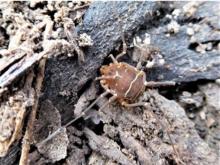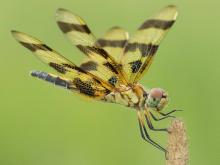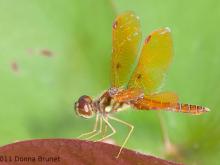Land Invertebrates
Media

Species Types
Scientific Name
Members of suborder Laniatores
Description
Armored harvestmen have spines on their fingerlike mouthparts (pedipalps). Unlike other harvestmen, members of this suborder of so-called daddy longlegs do not usually have long legs.
Media

Species Types
Scientific Name
Libellula luctuosa
Description
The widow skimmer has distinctive dark wing markings that seem like mourning garb. Mature males have white areas in the center of their wings, beside the dark patches, while females and immature males lack the white patches.
Media

Species Types
Scientific Name
Dromogomphus spp.
Description
Spinyleg clubtails are dragonflies in genus Dromogomphus. There are at least three species that look very similar.
Media

Species Types
Scientific Name
Gomphurus vastus
Description
The cobra clubtail is in the family of dragonflies called clubtails, named for the enlarged abdomen tip. There are about 100 species in this dragonfly family in North America north of Mexico.
Media

Species Types
Scientific Name
Celithemis elisa
Description
The calico pennant is a colorful, beautifully marked dragonfly. Males have pink wing veins and females have yellow. Males have a row of bright reddish heart-shapes on the abdomen; females have yellow.
Media

Species Types
Scientific Name
Celithemis eponina
Description
The Halloween pennant is one of the more common members of its genus. Distinctive wing markings include a complete brown band (not just a spot) positioned just short of the wing tip.
Media

Species Types
Scientific Name
Perithemis tenera
Description
The eastern amberwing is a tiny species of dragonfly that only reaches about 1 inch in length. Each of the four amber-colored wings has a red spot on the outer leading edge.
Media

Species Types
Scientific Name
Pachydiplax longipennis
Description
Blue dasher males and females look quite different. Both have a white face, a black abdomen tip, and slanted black and yellow stripes on the thorax. But males are blue and females are striped black and yellow.
Media

Species Types
Scientific Name
Tramea lacerata
Description
The black saddlebags is a dragonfly with memorable markings. Two dark blotches on each hindwing look like saddlebags.
Media

Species Types
Scientific Name
Libellula pulchella
Description
The twelve-spotted skimmer has twelve brown wing spots. Males, like this one, have eight additional spots that are white. Females lack the white spots.
See Also



Media

Species Types
Scientific Name
Cisseps fulvicollis
Description
The yellow-collared scape moth is more often “orange-collared.” And whether you think it looks more like a firefly or a wasp, it’s still a moth!
Media

Species Types
Scientific Name
Nearly 150 species in North America north of Mexico
Description
Slim, delicate plume moths are instantly recognizable by their T-shaped silhouette, long legs, and muted shades of tan and brown. It can be hard to separate the various species.
Media

Species Types
Scientific Name
Pyrrharctia isabella
Description
Not many people know the adult Isabella tiger moth when they see one, but we’re all acquainted with its caterpillar, the woolly worm, or woolly bear.
About Land Invertebrates in Missouri
Invertebrates are animals without backbones, including earthworms, slugs, snails, and arthropods. Arthropods—invertebrates with “jointed legs” — are a group of invertebrates that includes crayfish, shrimp, millipedes, centipedes, mites, spiders, and insects. There may be as many as 10 million species of insects alive on earth today, and they probably constitute more than 90 percent all animal species.





















